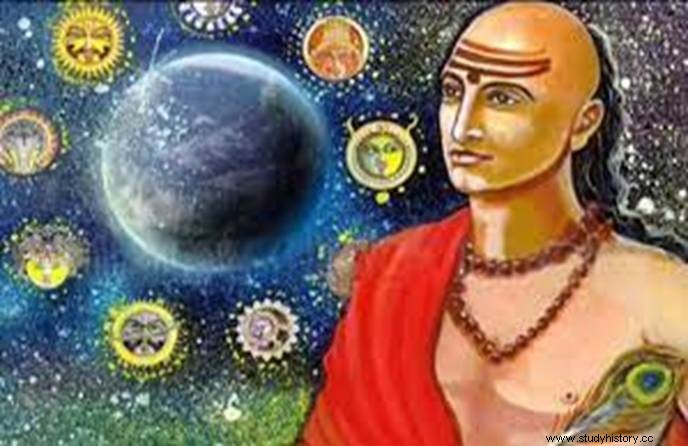
Varahamihira or Varahmihira was an Indian mathematician and astronomer of the 5th-6th centuries AD. Varahamihira first told in his treatise Panchasiddhantika that the value of Ayanamsa is equal to 50.32 seconds. The Gurukul of Mathematical Science developed by him at Kapitthak (Ujjain) remained unique for seven hundred years. Varahamihira was brilliant since childhood.
After learning traditional mathematics and astrology from his father Aditya Das, he did extensive research in these subjects. The time-measuring Ghat Yantra, the construction of the Iron Pillar in Indraprastha and the establishment of an observatory at a place called Jundishapur on the invitation of Emperor Nausherwan of Iran are considered to be involved in the works done by him. The main objective of Varahamihira was to make mathematics and science useful to the general public.
Biography
Varahamihira was born in AD 499 in a Brahmin family. The family belonged to a village called Kapitthak (Kayatha) near Ujjain. His father Aditya Das was a devotee of the Sun-God. He taught astrology to Varahamihira. On visiting Kusumpur (Patna), Varahamihira met Aryabhata, the great astronomer and mathematician of his time.
With the inspiration from him, Varahamihira made astrology and astronomy the goal of his life and he came to Ujjain which was a big center of education at that time. Under the Gupta rule, many Gurukuls of art, science and culture were flourishing there. Due to this, students and scholars from all over the country used to come to Ujjain.
Influenced by Varahamihira's astrology, the Gupta emperor Chandragupta (II) included him in the Navaratnas of his court. Varahamihira traveled to Iran and Greece etc.
Varahamihira's texts
Varahamihira wrote many important books around AD 550, in which Panchasiddhantika, Laghujatak, Brihajataka, Brihatsamhita, Tiknik Yatra, Brihadyatra or Mahayatra, Yoga Yatra or Swalapayatra, Brihat Vivahpatal, Mini Vivahpatal, Kutuhalmanjari, Daivajnavallabh, Lagnavarahi etc. are prominent. Important trigonometry formulas are given in these books, which are indicative of Varahamihira's high-level trigonometry knowledge.
Panchsiddhantika describes the five principles prevalent before Varahamihira. These principles are- (1.) Polish principle, (2.) Romaka principle, (3.) Vasistha principle, (4.) Surya principle and (5.) Pitamah principle. Varahamihira wrote important points of these pre-existing principles on his behalf 'seed' A ritual called rite has also been directed, so that the planets calculated by these principles can be visible. He wrote three texts of fruit astrology named Laghujataka, Brihajjataka and Brihatsamhita.
Varahamihira has written about his books on astrology- 'Astrology is a vast ocean and not everyone can cross it easily. My book is a safe boat, whoever reads it will carry it across.' This book is still considered to be the Grant Ratna in the texts of astrology. Brihatsamhita includes subjects like architecture, building-building-art, nature of atmosphere, Vrikshayurveda etc.
Scientific Ideas and Contribution
Varahamihira was a knower of the Vedas but he did not blindly believe in the supernatural. His method of thinking was like a scientist, who instead of blind-belief, believes in research-based knowledge. Like his predecessor Aryabhata, he also said that the earth is round. He was the first scientist in the world to say that there is a force that keeps things glued to the ground.
Today this force is called gravity. Varahamihira believed that the earth is not moving. Varahamihira said that if the earth was rotating, the birds flying in the sky in the opposite direction of the movement of the earth (to the west) would have reached their nest at the same time.
Varahamihira made some important comments regarding environmental science (ecology), hydrology (hydrology), geology (geology). He said that plants and termites indicate the water below the ground. He expressed himself in a unique style because of his proficiency in Sanskrit grammar and mastery over verses.
Due to his vivid knowledge and graceful presentation, he made even dry subjects like astronomy interesting, which earned him a lot of fame. His book Panchasiddhantika (Five Principles), Brihatsamhita, Brihajjataka (Jyotish) has given him the same place in fruitful astrology as Kautilya in political philosophy and Panini in grammar.
Trigonometry
The following trigonometric formulas have been propounded by Varahamihira-
sin 2 x + cos 2 x =1
sinx =cos(π /2) – x
(1 – cos 2x)/2 =sin 2 x
Varahamihira propounded by Aryabhata (1st) 'Sine Table' made more pure.
Arithmetic
Varahamihira defined the algebraic properties of zero and negative numbers.
Number Theory
Varahamihira 'Number-Theory' He also wrote a mathematical treatise called, about which very little is known. Only a small part of this text has been found. It covers advanced arithmetic, trigonometry as well as some relatively simple concepts.
Permutation
Varahamihira discovered the numbers now known as Pascal's triangle. He used them to calculate the Binomial Coefficients.
Optics
Varahamihira also contributed in optics. He has said that reflection occurs by the back &scattering of particles. He has also explained refraction.
Death
Varahamihira died in AD 587.
